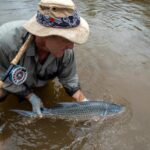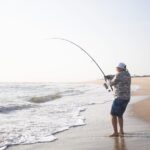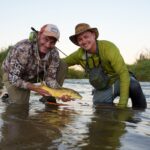Nile Perch
What’s the secret to landing Africa’s largest freshwater fish? If you guessed “a pink and red Peanut,” you’d be absolutely right. The Peanut, an enormous streamer that might be mistaken for a feather duster due to its deer-hair head shaped like a bell end, boasts all the qualities needed to entice the Faro’s colossal Nile perch. Discover the art of tying this fly with guidance from David Taylor, a seasoned guide at African Waters.
Materials:
- Hook: Ahrex SA270 #6/0 or Gamakatsu SL12S #8/0
- Thread: 3/0 nano silk
- Tail: 6x rooster hackle, 2x grizzly hackle, and red bucktail
- Collar: White marabou and sculpting fibre
- Head: Long deer hair
Some Important Background info on this amazing fishery
Consider that barring Gabon, the Nile perch, or one of its cousins, is found in most river and lake systems in tropical Africa north of the equator (and those parts of the Congo and Nile basins south of the equator). It has a range of about 8 million square kilometres within 25 African coun- tries. The Nile perch evolved as a riverine species and can grow to over 200 pounds; it’s one of the world’s freshwater giants. Classic Nile perch habitat is the rivers of what are called the Sahelo-Su- danian Savannah Zone, these are water courses that run high and murky during the rainy season and then almost stop flowing between deep, clear pools during the dry season. The geographical and seasonal conditions make perch extremely vulnerable to overfishing by an exploding human population that are some of the poorest people in the world, a population that in order to survive has reduced most of the Sahelo-Sudanian savannahs to altered landscapes where more than 95% of the biomass of indigenous wildlife and fishes have been removed. Beyond that, the veg- etation and soils have been transformed and the integrity of interconnected and interdependent eco-systems significantly compromised. Conservationists currently label much of the savannah habitat of which Nile perch are a part of, as so severely impacted as to be termed endangered to critical. The level of habitat degradation and depletion across an unimaginable large swathe of Africa is hard to comprehend without witnessing it firsthand.
The Last Strongholds of Sahelo-Sudanian River Systems
Based on our work in Africa, we are of the opinion that it’s unlikely that there are more than five, relatively intact river basins in Sahelo-Sudanian Africa. By intact we mean areas where all of the ecosystem services are fully functioning. For example all the big and little things that keep a sys- tem healthy like having a significant hippo population to ensure a constant flow of nutrients from the land to the water, and where soil organism (e.g. earthworms) bioturbation ensures maximum rainfall retention and groundwater recharge to maintain dry-season flows, etc., in short, where all of the integral, living, organic, and physical elements are present and interacting.
The point is healthy environments are isolated and dwindling before our eyes, and a journey to Gassa Camp in Cameroon is the opportunity to see a piece of Africa that is an extremely rare rep- resentation of how vast areas of the continent used to be, it’s literally time travel.
In a fishing context, it’s only in healthy habitat that one is going to have good fishing, and when one can have that, casting flies with one’s feet on the ground, Africa sights and sounds flooding one’s senses in one moment and being painfully schooled in a Nile perch’s brutal hit-and-run
in the next, then it’s a one of a kind fishing experience. Importantly, your presence will be making a direct contribution to the protection and management of this extremely high-priority conservation area.
The All-Encompassing Adventure of Gassa Camp
The Gassa Camp experience is very much about the whole adventure. It’s about casting giant flies in the hope of catching a meter long perch, its about fishing surface flies to hard hitting and acrobatic tigerfish, and its about sight fishing to the Faro River bars of gold, the niger barb. It is captivating and engaging on all fronts.
The serious perch fishing takes place almost exclusively from just before sunset until about 21:30, in other words it’s night fishing. Our observation is that that’s the time the perch really go on the feed at this location. A few may be caught in the day, but those will typically be small ones and lucky co-incidences. Night fly fishing has its own charm, and is very much a part of what makes the fishing even more unforgettable. It does freak a few people out at the start, but it should be said that one quickly learns to time one’s casting by feel rather than sight, and thus one usually casts better. And standing under the starlight, alone in one’s own world, immersed in the sounds of the African wilderness, is a raw, edgy experience that’s wild in every sense. It may seem scary at first but the risks from wildlife while fishing are extremely low and your professional guided and game scout are always close to hand.
The day time fishing at Gassa Camp is focused on tigerfish and niger barb – two incredibly fly fish- ing targets in their own right. There are abundant tigerfish and the Sahelian tigerfish (H. brevis), which is one of three tigerfish species in the river, are very feisty fish that grow to at least 8kg. The water is clear to crystal clear and so one will often see the tigers and many of the other fish.
One of the most challenging and rewarding species is the Niger barb (Labeobarbus bynniocci- dentalis), that will eat a well presented dry fly or nymph, but are very spooky, and a are always a handful when a big one is hooked on the light tippets it takes to attract an eat. Amongst the rest of the fishes there are other species that take a fly, which include other cyprinids (e.g. Labeos), tetras and numerous species of catfish. So during any time on the river, anything can happen making it an exciting fly fishing frontier.
Click here if you would like to fins out more about Gassa Camp.





